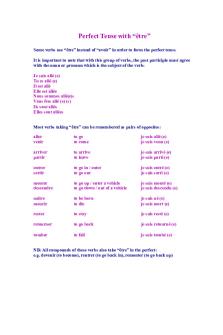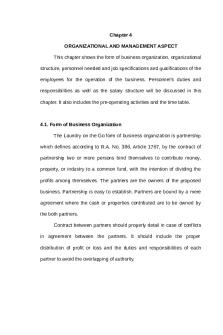Tense and Aspect in English. PDF

| Title | Tense and Aspect in English. |
|---|---|
| Author | Berrytree Mac |
| Pages | 30 |
| File Size | 479.6 KB |
| File Type | |
| Total Downloads | 107 |
| Total Views | 540 |
Summary
Chapter 6 Tense and Aspect Presented by: Fatima AL-Amri Hanan AL-Olyani Hanan AL-Sultan Outline Introduction - Aspect vs. tense - example Tense - Tense and time are distinct - Pragmatic matters in tense - forms encoding tense and aspect - Present, Past and Future - Tense and adverbials Aspect ...
Description
Chapter 6
Tense and Aspect Presented by: Fatima AL-Amri Hanan AL-Olyani Hanan AL-Sultan
Outline Introduction - Aspect vs. tense - example
Tense
- Tense and time are distinct - Pragmatic matters in tense - forms encoding tense and aspect
- Present, Past and Future - Tense and adverbials
Aspect
- Habituality and simple aspect - Progressive aspect - Perfect aspect
This chapter is about:
- how English grammar allows us to locate events in time (tense), in relation to the time of speaking or writing, and - grammatical signals regarding the sender’s notions of how an event is distributed in time (aspect); for instance, is it viewed as ongoing, or repeated, or characterised as compressed to a point?
Tense vs. Aspect 1. Tregidgo (1974) comments on tense and aspect by saying that: "tense is concerned with time; aspect is concerned with action, whether the action is complete or incomplete, single or repeated, regular or irregular, momentary or lasting."
2. In terms of the tense-aspect system of Klein (1994), the difference between tense and aspect can be described as follows: Aspectrelates the topic time to the time of situation, whereas tenserelates the topic time to the moment of utterance.
3. Huddleston and Pullum (2002) defined tense as:
“a system where the basic or characteristic meaning of the terms is to locate the situation, or part of it, at some point or period of time." and aspect as: “a system where the basic meanings have to do with the internal temporal constituency of the situation."
Example showstense and aspect being used together to convey meaning:
When I told people I was spending time with farmers, they’d say: how can you stand it, they just complain all day and they’ve always got their hand out. (from an article by Andrew O’Hagan)
Time is represented by the line running from left to right.The time of writing is represented as an interval on the time line. before the time of the writing
He was spending time with farmers
after the time of the writing
He told people >> past simple (two-part labels): the first word denotes tense (past)
the second denotes aspect (simple)
Tense is marked on the verb. The past simple indicates that he “told people …” before the time of writing.
the event of telling is arrowed to a point (the point of completion) on the time line because past simple encodes events as if they can be located precisely in time
‘people’ (not a group of people) entails that he told different people,individually or in groups, so there should be more than one arrow from the box containing the words ‘He told people …’ to separately locate on the time line each event in which he told a person, a pair or a group of people about his time with farmers.
He was spending time >> past progressive (twopart labels): the first word denotes tense (past)
the second denotes aspect (progressive >> aux be +V+ ing)
when tense is marked in a verb group as in (was spending), it goes on the first element in the sequence.
the activity of spending was ongoing before the time of
utterance but its beginning and particularly its end are not in focus, so it is shown as a grey bar located generally before the time of writing, but not arrowed to a point in time
they’d say =they would say
Would is the past simple form of the modal auxiliary verb will
Will is the main grammatical device for signalling future time in English
There is no suffix in English to put on to verbs as an indicator of futurity.
“. . . while there are numerous ways of indicating future time, there is no grammatical category that can properly be analysed as a future tense” (Huddleston & Pullam, 2002, p.209)
The use of a marker of futurity here indicates that the responses were located towards the future from the past points in time of the tellings.
how can you stand it, they just complain all day >> present simple: Present simple can signal different things, not just times coinciding with the time of utterance. It can indicate habitual actions.
‘tolerating the company of complaining farmers’ and ‘complaining’ ,in the above sentences, is regarded as habitual behaviour.
Habituality has to come out of a pragmatic interpretation of present simple e.g. We have semantics class every Saturday.
or past simple e.g. He used to write short stories.
they’ve got = they have got >> present perfect: the first word denotes tense (present) the second denotes aspect (perfect)
Present perfect is used here to talk about the time-ofutterance consequences of earlier events (the farmers having previously got their hands into that position of begging).
e.g.
Tense and time are distinct “It is important to keep the two concepts, time and tense strictly apart. The former is common to all mankind and is independent of language while the latter varies from language to language and is the linguistic expression of time relations, so far as these are indicated in verb forms” (Jespersen, 1933, p.230)
Time common to everyone
Tense the linguistic expression of time relations, indicated in verb forms
varies from language to independent of language another
Important distinction It is important not to confuse the name ofverb tense with the way we use it to talk about time. Examples:
a present tense does not always refer to present time: I hope it rains tomorrow.
"rains" present simple, but it refers here to future time (tomorrow)
a past tense does not always refer to past time: If I had some money now, I could buy it.
"had" past simple, but it refers here to present time (now)
Tense
“a system where the basic or characteristic meaning of the terms is to locate the situation, or part of it, at some point or period of time.” (Huddleston and Pullum, 2002)
e.g. I hit the nail once with a hammer.
Here, tense is present >>the situation time coincides with the time ofutterance
Two-part labels for tense–aspect combinations
tense past tense aspect simple aspect
past simple saw
present tense
future tense
present simple
future simple will see
see
progressive aspect
perfect aspect
past progressive
present progressive
future progressive
was/were seeing
am/is/are seeing
will be seeing
past perfect
present perfect
future perfect
had seen
have/has seen
will have seen
Tense is a deictic feature oflanguage:It has to be explicated in relation to the time of utterance. present tense = the sender portrays the situation as ‘in a time interval including the time of utterance’ past = ‘before the time of utterance’
future = ‘after the time of utterance’
Pragmatic matters in tense:
The locations in time of the points or intervals being spoken or written about are worked out pragmatically, in the process of explicature.
the length of relevant time intervals and – for past and future – how long before or after the time of utterance is also a pragmatic matter.
Forms that encode tense and aspect: There is not a one-to-one match between the tense and aspect forms and the meanings signalled by those forms.
1. explicit markers: a) auxiliary verbs: e.g. will, have, be
b) irregular forms of verbs:e.g. saw, seen, thought, blew, blown, is, am, are, was, cut, would c) inflectional suffixes:
past tense, usually written -ed present tense, when the subject is singular non-sender and non- addressee, usually written –s e.g.goes, sees
progressive -ing,e.g. am singing, was emerging past participle -(e)n or -ed,e.g.has seen, have helped
2. unmarked forms of verbs: e.g. see, look, can,
Question for class:
What is tense and time in the following sentences:
1. I think we will eat out tomorrow evening. 2. I want a coffee. 3. I leavetomorrow. 4. Hold on. I'll do it now.
References
Aspect vs. tense. (2011). Retrieved from:
http://www.glottopedia.de/index.php/Aspect
Huddleston, R. & Pullum, G.K. (2002). The Cambridge grammar of the English language. Cambridge University Press: UK.
Jespersen, O. (1933). Essentials of English grammar London: George Allen & Unwin.
past progressive. (2011). Retrieved from: http://costadeorointermediate1.blog.alianza.edu.uy/2010/06/past-simplepast-progressive-or.html
Present perfect. (2011). Retrieved from: http://www.grammaring.com/present-perfect-for-recent-events-with-aresult-in-the-present
Saeed, John I. 2003. Semantics. Oxford, UK: Blackwell. Tense and time. (2011). Retrieved from:
http://www.englishclub.com/grammar/verb-tenses_sys-tense-time.htm
Tregidgo, P. S. (1974). English tense usage: A Bull's-eye view. ELT Journal, 28(2), 97-107.
Exercises
Question 1: Recently goes with the past time group that includes yesterday. Note the unacceptability of *He is happy recently, ?He shops at the corner store recently, *I will do it recently. (In connection with Example (6.20) it was noted that recently can be used with present perfect forms, for example I have been over the Forth Rail Bridge recently, where it indicates that the aftermath – the period between my crossing of the bridge and now, the time of utterance – is relatively short, but note that the period of the aftermath assessed as short is all before now, which is to say it is in past time.) Soon is like then in Table 6.2, in being acceptable with past and future times, but not present: *I’m eating cake soon is no good if reference is to the present, but is fine with future reference in I’m catching a train soon, even though both of these sentences are present progressive in form. In such cases soon is directly anchored on the time of utterance, with the meaning ‘a short time after now’. But when soon is used with past reference, as in It began to rain, but stopped soon, the deixis is indirect, and soon means ‘a short time after that time’. In the example, ‘that time’ is the time that the past tense form began points to deictically....
Similar Free PDFs

Tense and Aspect in English.
- 30 Pages

Makalah english PAST TENSE
- 6 Pages

Zappos and its cultural aspect
- 3 Pages

aspect of geography
- 14 Pages

CHAPTER 4 MANAGEMENT ASPECT
- 7 Pages

aspect of speaking skill.pdf
- 9 Pages

LESSON PLAN Past Tense
- 7 Pages

MAKALAH SIMPLE PRESENT TENSE
- 13 Pages

S15T2 Simple Present Tense
- 1 Pages

Perfect Tense with être
- 2 Pages
Popular Institutions
- Tinajero National High School - Annex
- Politeknik Caltex Riau
- Yokohama City University
- SGT University
- University of Al-Qadisiyah
- Divine Word College of Vigan
- Techniek College Rotterdam
- Universidade de Santiago
- Universiti Teknologi MARA Cawangan Johor Kampus Pasir Gudang
- Poltekkes Kemenkes Yogyakarta
- Baguio City National High School
- Colegio san marcos
- preparatoria uno
- Centro de Bachillerato Tecnológico Industrial y de Servicios No. 107
- Dalian Maritime University
- Quang Trung Secondary School
- Colegio Tecnológico en Informática
- Corporación Regional de Educación Superior
- Grupo CEDVA
- Dar Al Uloom University
- Centro de Estudios Preuniversitarios de la Universidad Nacional de Ingeniería
- 上智大学
- Aakash International School, Nuna Majara
- San Felipe Neri Catholic School
- Kang Chiao International School - New Taipei City
- Misamis Occidental National High School
- Institución Educativa Escuela Normal Juan Ladrilleros
- Kolehiyo ng Pantukan
- Batanes State College
- Instituto Continental
- Sekolah Menengah Kejuruan Kesehatan Kaltara (Tarakan)
- Colegio de La Inmaculada Concepcion - Cebu





